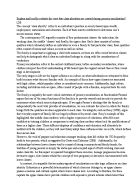Explain and briefly evaluate how class influences an individuals age identity? [24 mk]
Explain and briefly evaluate how class influences an individual’s age identity?
Any explanation of ‘social class influencing age identity of individuals’ would presuppose, different types of ‘class cultures’ would have corresponding ‘age identities’. As class and age, both are separate sources of social identity, a discussion would warrant examining if these are related in a cause-effect manner.
Old age is associated with a ‘stereotype identity’ comprising values and lifestyle such as; limited competence, vulnerable, dependence, loneliness, poor health, unable to learn newer skills, restrictions/inflexibility or rigidity, immobility, need care and protection resulting to the marginalisation and stigmatising them as ‘inferior’ (Pilcher 1996). In UK studies have shown that this stereotyping of old age has come to be institutionalised at several levels leading to discrimination because of age (ageism) (Johnson and Bytheway 1993). However, this stereotype identity is not shared equally by different social classes. This negative identity weakens as one moves upwards in the class hierarchy.
Old age is seen as a social problem in many ways. The stereotype of old people as a social problem however, is more pronounced in case of working class. This is socialised mostly through family (pg 71 Waugh et al, OCR 2008). In working class families members assume that older relative will need and want more care than they actually do. Often, retirement starts early and working class men rarely remain in employment after 65. This class confirms more closely to the official view of old age in terms of different benefits and concessions (pg 69 Waugh et al, OCR 2008). A member of this class is more likely to believe that to be elderly is more to do with age rather than that with ‘level of health and fitness’ (pg 70 Waugh et al, OCR 2008). As one moves up in the class ladder sub-categories within the old emerge. Contrary to the working class conception of old age being a homogeneous category, middle and upper class members are likely to see sub-categories of ‘oldest-old’ and ‘young-elderly’ as part of old age (McKingsley 2001).



![Explain and briefly evaluate how class influences an individuals age identity? [24 mk]](https://mbt-essays-prod-public.s3.eu-west-1.amazonaws.com/1210388/listing/1210388_1.jpg)




![Explain and evaluate the use of unstructured interviews/qualitative data to research the lifestyle choices (identity) of retired senior managers/old people. [52 mk]](https://mbt-essays-prod-public.s3.eu-west-1.amazonaws.com/1210387/listing/1210387_1.jpg)